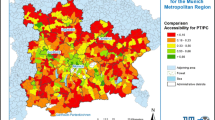Abstract—
The article examines the factors determining the transport accessibility of territories, as well as provides a brief overview of possible approaches to the calculation of the complex indicator of transport accessibility and the method of its calculation. Using this methodology, a quantitative assessment of the transport accessibility of the regions of the Russian Federation is obtained.

Similar content being viewed by others
Notes
Cycle is a closed loop of transport links (edges) in the network.
Graph is a simplified diagram-drawing of the relative positions of points (nodes) and lines of the transport network, a set of the nonempty set of vertices and sets of pairs of vertices (edges).
An edge of a graph is a line connecting a pair of adjacent vertices of a graph.
With the exception of Stavropol krai, Khanty-Mansi Autonomous okrug – Yugra and Yamalo-Nenets Autonomous okrug, where the following cities are chosen as the transport centers, Mineralnye Vody, Surgut and Novy Urengoy, respectively, as the most significant transport and economic centers in these areas.
As of the 2nd quarter of 2018. In case of change in the number and division of administrative-territorial units, the total number of regions for calculating the indicator of transport accessibility may change.
In terms of train count.
It is recommended to use the transport model of road, rail and air communication with the basic parameters of infrastructure and the location of these objects to automate the optimization calculation of the shortest route.
In this case, the simulation results based on the software product TMF (Transport Mobility Forecast) recommended for use by the Ministry of Digital Development, Communications and Mass Media of the Russian Federation: https://reestr.minsvyaz.ru/ reestr/126987
REFERENCES
V. V. Ivanter, M. Yu. Ksenofontov, et al., Prospects for the Development of the Russian Economy: Forecast until 2030 (Inst. Narodnokhoz. Prognozirovaniya Ross. Akad. Nauk, Moscow, 2013) [in Russian].
A. S. Neretin, Candidate’s Dissertation in Geography (Moscow, 2018).
K. V. Yankov, “Problems of the long-term planning of the development of a core transport network in the Far East and Baikal region,” Stud. Russ. Econ. Dev. 24 (6), 604–606 (2013).
S. A. Tarkhov, Changing the Connectivity of Russia’s Space (on the Example of Air Passenger Communication) (Inst. Geogr. Ross. Akad. Nauk, Smolensk–Moscow, 2015) [in Russian].
S. A. Tarkhov, Evolutionary Morphology of Transport Networks (Universum, Smolensk, 2005).
Yu. A. Shcherbanin, E. A. Ivin, A. N. Kurbatskii, and A. A. Glazunova, “Econometric modeling and forecasting of demand for railway freight transportation in Russia,” in Problems of New Economy.Siberian State University of Railway Engineering (Novosibirsk, 2017), pp. 83–90 [in Russian].
K. Kansky, Structure of Transportation Networks: Relationships between Network Geometry and Regional Characteristics (Econometrica, Chicago, 1963).
V. N. Bugromenko, Transport in Territorial Systems (Nauka, Moscow, 1987) [in Russian].
V. N. Bugromenko, Transport Discrimination of the Population: Ways to Solve the Problem. http://oooliderclimat.ru/discnas.htm.
A. P. Abramov, Marketing on Transport. Textbook for High Schools (Uchebno-Metod. Tsentr Obraz. Zheleznodorozhn. Transp., Moscow, 2001) [in Russian].
V. L. Badenko, V. V. Garmanov, and G. K. Osipov, State Land Cadastre. Handbook (S.-Peterb. Gos. Pedagog. Univ., St. Petersburg, 2002) [in Russian].
M. V. Ivanov, “To the problem of the theory of transport accessibility. Organizational and economic problems of the development of transport industry enterprises,” in Proceedings of the Seventh Prokhorov Readings (Litera, Nizhny Novgorod, 2011), pp. 115–117.
Author information
Authors and Affiliations
Corresponding author
Additional information
Translated by A. Simakova
Rights and permissions
About this article
Cite this article
Lavrinenko, P.A., Romashina, A.A., Stepanov, P.S. et al. Transport Accessibility as an Indicator of Regional Development. Stud. Russ. Econ. Dev. 30, 694–701 (2019). https://doi.org/10.1134/S1075700719060091
Received:
Revised:
Accepted:
Published:
Issue Date:
DOI: https://doi.org/10.1134/S1075700719060091




